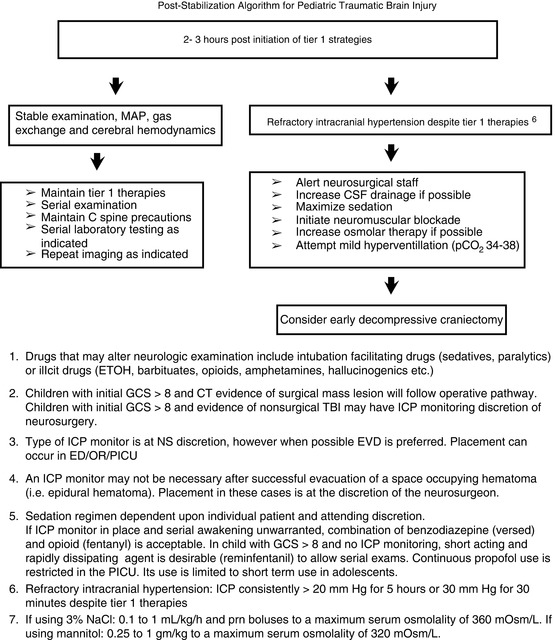Fig. 1
Primary treatment algorithm for pediatric traumatic brain injury (Source: Trauma treatment protocols of the Janet Weis Children’s Hospital, Danville, PA)

Fig. 2
Post-stabilization algorithm for pediatric traumatic brain injury (Source: Trauma treatment protocols of the Janet Weis Children’s Hospital, Danville, PA)
(b)
Monitoring devices:
(i)
Often recommended for children found to have an abnormal CT with a GCS <8.
(ii)
Risks:
1.
Infection from prolonged use.
2.
Hemorrhage from traumatic placement.
3.
Excess CSF drainage.
4.
Monitor malfunction.
(c)
Types:
(i)
Bolt (Camino ICP Bolt).
1.
Intraparenchymal or subdural.
2.
Advantages:
(a)
Easier placement.
(b)
Lower risk of infection and hemorrhage.
3.
Disadvantages:
(a)
Inability to drain CSF.
(b)
Potential loss of accuracy over several days.
(ii)
Ventriculostomy and drain.
1.
Intraventricular monitor/drain.
2.
Advantages:
(a)
Greater accuracy.
(b)
Simple measurement.
(c)
Ability to drain/sample CSF.
(i)
CSF should be removed in very low volumes and slowly. Passive gravitational drainage typically is best.
3.
Get Clinical Tree app for offline access

Disadvantages:
(a)
Higher rates of infection (up to 20 %).
(b)




Higher rates of hemorrhage during placement (approximately 2 %).
Stay updated, free articles. Join our Telegram channel

Full access? Get Clinical Tree


